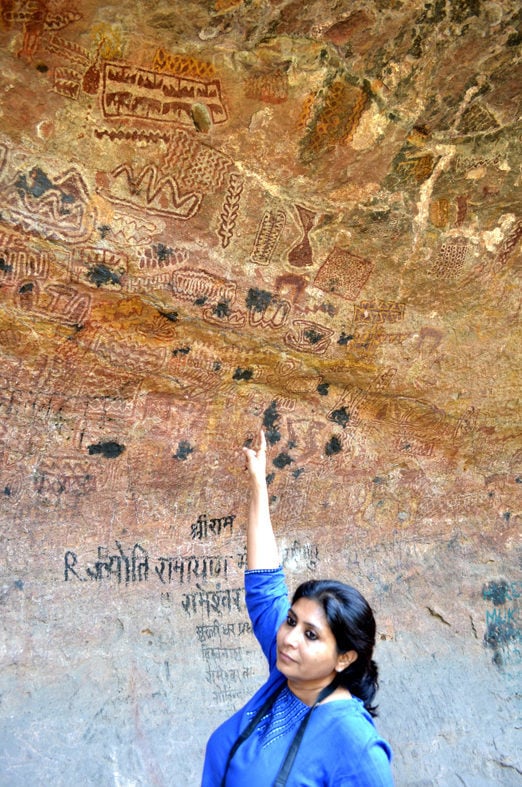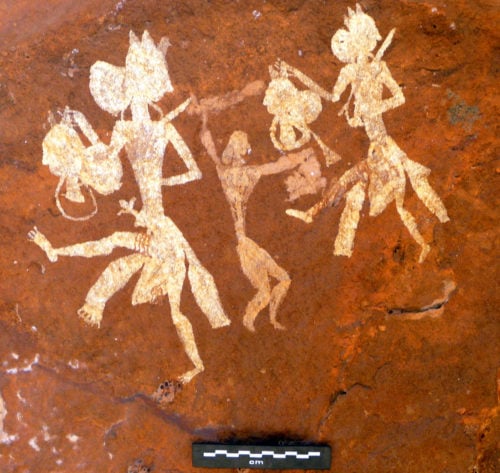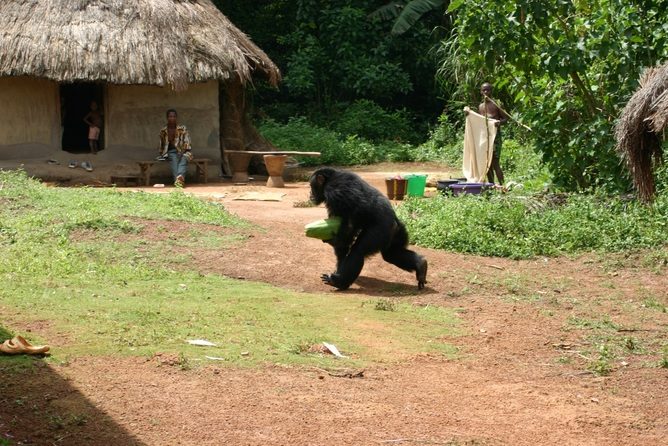Guest Post | Travel
Guest blogger Meenakshi Dubey-Pathak (see bio below) shares her experiences exploring the rock paintings of India.

Nearly thirty years ago as a student I used to accompany my father Shri P. Dubey on tours to the outskirts of the towns and far-flung villages in the Madhya Pradesh State in the center of India. During one such tour we went to Adamgarh in the Hoshangabad, and there I saw rock paintings for the first time. I was impressed when my father taught me about the history and heritage associated with them. Later, in the nineteen-eighties, I got the opportunity to see the rock paintings of Pachmarhi Hills. Influenced by the wonderful work of prehistoric people, I commenced my PhD work under the National Fellowship of the University Grant Commission New Delhi in September 1986, studying various facets of the rock paintings of Pachmarhi Hills. My studies encompassed their extensive documentation, recording and analysis. My father accompanied me on numerous visits to different painted rock shelters of Pachmarhi. His company and persuasion were unparalleled. I visited Pachmarhi in all seasons except monsoon, when going into the dense forest becomes difficult and dangerous, making our entire effort futile. Trekking the hills of varying heights and deep valleys with the natural beauty in their folds was a pleasant adventure. Through the thick forest and undergrowth, combined with the risk of encountering wild animals, the search for painted shelters was even a greater adventure. Most Indian rock art sites are located in forested areas. I feel fortunate to be able to visit many rock art sites in different states of the country!

In the summer of 1990, we decided to make a film about the paintings of head hunters in the Rajat Prapat area. Being the summer season, these falls offer a good source of drinking water and a cool place for wild animals to rest. The fall is located at the bottom of a 350 feet deep precipice rarely visited by people. When we got there we started climbing towards the shelters, and a minute later we heard the roar of a tiger, identified by an accompanying tribal guide, who also heard the crackling sound of dry leaves and branches of bamboo lying around. We were both scared and nervous. We had no weapons to scare the beast away and had no choice but to retreat for the day. We again went there after a lapse of ten days and succeeded in visiting the painted shelters.
Pachmarhi and the surrounding Mahadeo Hills hold one of the richest concentrations of rock art in Madhya Pradesh. The painted shelters are often located at considerable heights, and access to them is difficult. Some shelters bear numerous painted figures with superimpositions. While others contain very few images. Most paintings are red and white, showing up admirably on the rock surfaces. A few paintings are yellow. Many of the paintings found in the Pachmarhi Hills are faded or partially obliterated and thus incomplete. Some of them are covered with a whitish thin layer. The colors of some of the paintings have merged with those of the rock. The degree of natural preservation of these paintings varies according to the location of the shelter, its exposure to sunlight, rain, wind, and worst of all, to destructive human actions.

To quote a few examples, the rock paintings at Nagdwari got very badly damaged during the annual festivals of Maha-Shivaratri and Nagapanchami, when pilgrims visit the shrines in thousands. The Nagdwari art, in fact, was nearly entirely destroyed by graffiti covering the whole surface of the wall. One can now barely see the remains of the paintings that for the most part have disappeared under modern inscriptions. The site is basically dead. At least four other sites in the same region have suffered the same fate (Neemgiri, Chitrashala and other shelters located on the same hillocks as Nagdwari). In the Bori area, an important shelter called Belkandhar 2 was also most grievously damaged in July 2011 by extensive graffiti left by pilgrims. The few images that remained little harmed testify to the previous importance of the site. The vandals, as we were told by pained foresters, are a few of the thousands of people coming in pilgrimage mostly from Nagpur in the Maharashtra state. They usually come twice a year in February (Mahashivratri) and July (Nagapanchami) because there are two sanctuaries in the zone, one at the foot of the Belkhandar Mountain and another at its top. Those people are Hindus who obviously do not share the same beliefs as the local Gonds and Korkus about the power/sacredness of the paintings, or they would not have desecrated them by their actions.

I carried out a project in 2000-2002 for the Environment and Planning department of Madhya Pradesh on the documentation and preservation of the Rock Art of Satpura Biosphere (Pachmarhi). After completion of the project, the Forest Department of Hoshangabad, Madhya Pradesh, protected ten painted rock art sites in the national park area. To do so, the shelters were enclosed with railings and on top of the panel a kind of channel was made to divert and clear the rainwater.
In the daytime (never at night), visitors can visit some of the sites with the permission of forest officials. Since the park is full of wildlife, forest guards are always there on duty and will accompany them.
In 2012, after witnessing the damage done at Belkhandar 2, we immediately advised the authorities of the national park for Madhya Pradesh of the impending danger to the other two most important sites of Belkandhar (1 and 3) and also of two other sites that fully deserve to be better protected, Nishan Garh and Churna. We advised them to take immediate measures of protection.
About Meenakshi Dubey-Pathak
Meenakshi Dubey-Pathak is an independent rock art researcher and artist. She is an international expert on rock art for ICOMOS and UNESCO. She discovered and explored many painted rock shelters in Madhya Pradesh, Pachmarhi, and Chhattisgarh area of India. Meenakshi has published approximately 50 research papers and reports in various international and national journals, collective books and newspapers. She has also published two books: Rock Art of Pachmarhi Biosphere with Dr Jean Clottes and Images for the Gods. Rock art and Tribal art of Central India. She is currently involved in projects on the Chhattisgarh and Madhya Pradesh rock art.
Further Reading
Stupas in Petroglyphs: A Living Heritage of Ladakh
Handprints in the Rock Art and Tribal Art of Central India
Pseudo Aliens’ Representations in Chhattisgarh Rock Art (India)
Ceremonies When Reaching Rock Art Sites in Chhattisgarh (India)
Rock Art Sites at Bhimlat in the Bundi Area of Rajasthan


